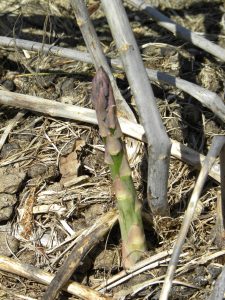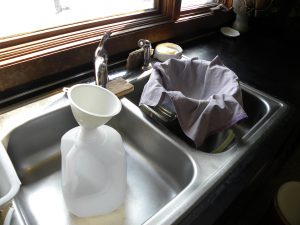
Gold Rush Beans
There is food to pick here as early as April, but true harvest season kicks in as August approaches. Our goal is to not only grow for eating in the summer, but to provide for ourselves year-round. That’s a lot of food for us to bring in and preserve in a short window of time. Thus, in August and September our harvest is my biggest focus – in fact, it really takes over my life! I have learned to plan for it, to free up much of my schedule otherwise and to let people in my life know that emails, calls and letters are not likely to be answered this time of year. I can chart out approximately when I’ll need to do what, but every season has variations so I have to be flexible and willing to change directions. It’s a good but uncomfortable exercise for a person who really likes to follow her list.

Peaches Waiting to be Canned
Peaches are particularly demanding – when they are ready, I preserve them or lose them. With the great success of that crop for us this year, days

I canned 89 quarts of peaches this August, all from our own trees!
that I had planned to work on other projects turned into peach canning days. The peaches were simply in charge!
Some of our other big production crops aren’t quite so picky, they will give me days or even weeks of leeway. But being responsive has rewards. Pulling the garlic when the third leaf of the plant dies back, gives the bulbs the best storage life. I’ll still get great garlic after the fourth or fifth leaf withers, but it likely will not last as long. The root crops can sit in the ground until I’m ready to eat them or put them in the root cellar, but the voles will get a bigger and bigger

The garlic is pulled and put out to dry at the end of July.
share as time moves on. The winter squash in the field next to their dying vines are exposed for other critters to gnaw on, too. Our corn is a storage not fresh eating variety so is fine with a long season out there, but we have competition for them as well.
It’s true for our animals, too. Our heritage breed chickens take four months to reach their full size. By then, not only are they taking up space and food without gaining weight, but the roosters have been crowing loudly for about a month and it isn’t long until they will start fighting each other. They have many ways of telling us this is no longer a sustainable, safe situation.

Dehydrated kale, mushrooms, tomatoes and raisins can last for years.
All of our charges – plants, animals, bees – have their own schedule and their own plans. For best results, we learn their rhythms and work to fit ourselves into their calendar, although of course our management decisions are important, too. This is all good practice for remembering our interconnected, cooperative place in the world and re-learning how humans are not in charge but are part of a complex, ongoing dance. Which brings me to a last, philosophical thought for this blog entry…
Just recently I learned, to my great surprise, that when Charles Darwin talked about “survival of the fittest” he meant that those best adjusted to and able to fit in to their environment were the ones that succeeded. His ideas and work were misinterpreted and co-opted to justify competitive, dominant and bullying behavior. In fact, the evidence that cooperation, compassion and flexibility are much more prevalent and useful tactics has become overwhelming.

Diversity Supports Health
By the way, he did not say that “fitting in” meant becoming like everything else – in fact, it is through diversification and specialization that competition is often avoided and much energy is saved.
All of this really blew my mind as it is so far from what I was taught earlier in my life. Exploring these ideas over the past few years has reshaped my view of the world, freeing and inspiring me. Permaculture has been a part of this journey with our principles of valuing diversity (#10), embracing relationship and cooperation (#7 & 8) and being willing to learn and change (#1, 4 & 12). I value these opportunities to see and practice such skills – even if they’re currently tiring me out!

Don’t forget to preserve for medicine as well as food! Calendula can be dried for later salves and balms.


























